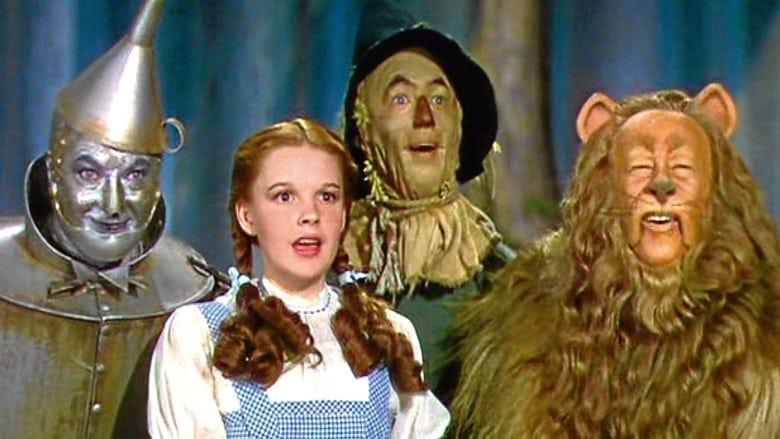Welcome to November, the 11th month of the year and the glue month of the holiday season. Halloweekend fades into that whoa it is November already feeling. The leaves are turning just as pumpkin spice slowly gives way to gingerbread houses. As we turkey trot into the end of the year, remember to focus on what is important not just what is urgent.
This month’s edition touches on two evergreen concepts ripe for Hollywood makeovers.
The Rise of Khan
The Wizard of Oz
THE RISE OF KHAN
“Without the vision of a goal, a man cannot manage his own life, much less the lives of others.”
— Jack Weatherford, Genghis Khan and the Making of the Modern World
In an odd coincidence, a current neighbor of mine in Florida grew up on the same street in New York as my wife. I asked my neighbor’s wife where she was from hoping we might have a similar connection only to find out that she hails from the distant lands of Mongolia.
A 2003 study found evidence that Genghis Khan's DNA is present in about 16 million men alive today or ∼0.5% of the world's total population.
Genghis Khan (born Temüjin c. 1162 – August 25, 1227), also known as Chinggis Khan, was the founder and first Great Khan of the Mongol Empire, which became the largest contiguous land empire in history after his death. He united the nomadic tribes of northeast Asia and launched the Mongol invasions that conquered most of Eurasia. With his armies, he conquered much of Central Asia and China. His conquests had a profound and lasting impact on the history of Asia.
Genghis Khan's success is undeniable and extraordinary, making him one of the most iconic figures in world history. Born under challenging circumstances, he unified Mongolia's fragmented tribes, built an unprecedented military machine, and forged one of the largest empires the world has ever known - The Mongol Empire.
His empire, spanning from Eastern Europe to the Sea of Japan, extended from Northern Siberia to Tibet, India, and Southeast Asia, covering about 9.27 million square miles. At its peak, the Mongol Empire was larger than the Roman Empire and twice the size of the Mediterranean-based empire of Alexander the Great. Such geographical dominance is a testament to Genghis Khan's extreme success as a conqueror.
His strategic ingenuity was unparalleled. Genghis Khan's ingenious military tactics, including psychological warfare and blitzkrieg, combined with excellent communication lines for his troops, laid the groundwork for his numerous victories.
Apart from military victories, Genghis Khan's Newtonian impact on culture, politics, and technology was no less significant. He was a progressive ruler who implemented revolutionary changes in his empire, transforming a nomadic tribal culture into a centralized state with a complex bureaucracy, written language, and a unified legal system. He is credited with establishing the first global postal system, introducing paper money, and promoting the use of the decimal system.
Genghis Khan's policies also championed religious freedom and multiculturalism, attracting subjects from diverse cultural backgrounds and contributing to a rather cosmopolitan society for its time.
“Whether in their policy of religious tolerance, devising a universal alphabet, maintaining relay stations, playing games, or printing almanacs, money, or astronomy charts, the rulers of the Mongol Empire displayed a persistent universalism. Because they had no system of their own to impose upon their subjects, they were willing to adopt and combine systems from everywhere. Without deep cultural preferences in these areas, the Mongols implemented pragmatic rather than ideological solutions.
They searched for what worked best; and when they found it, they spread it to other countries. They did not have to worry whether their astronomy agreed with the precepts of the Bible, that their standards of writing followed the classical principles taught by the mandarins of China, or that Muslim imams disapproved of their printing and painting.
The Mongols had the power, at least temporarily, to impose new international systems of technology, agriculture, and knowledge that superseded the predilections or prejudices of any single civilization; and in so doing, they broke the monopoly on thought exercised by local elites.
Moreover, his vast trade networks along the Silk Road played a crucial role in East-West cultural exchange, facilitating unprecedented levels of global commerce that had lasting economic and cultural impacts.
It is estimated Genghis Khan was incredibly wealthy, but it is difficult to estimate his exact net worth. Some estimates put his wealth at over $100 trillion in today's dollars, while others estimate it to be closer to $50 trillion.
“Genghis Khan warned his soldiers against the pursuit of a “colorful” life with material frivolities and wasteful pleasures. “It will be easy,” he explained, “to forget your vision and purpose once you have fine clothes, fast horses, and beautiful women.” In that case, “you will be no better than a slave, and you will surely lose everything.”
However, it's essential to remember that these achievements and the expansion of the Mongol Empire came with immense brutality and loss of life. Towns and entire civilizations were often decimated, and as a result, Genghis Khan's legacy is a controversial one, seen by many as a blend of ingenuity and ruthless conquest.
In essence, the indelible mark Genghis Khan left on global history makes him extraordinarily successful. From military might to societal reforms, his reign was transformative, albeit soaked in blood. His rule personifies the old adage: “Absolute power corrupts absolutely,” reminding us of both the tremendous capacity and potential destructiveness linked with human power.
Regardless of the perspective, Genghis Khan, etched in history as both a feared conqueror and a transformative leader, influenced the world far beyond his era. His life story continues to be a magnetic point of research and discourse, underlining his lasting impact on the world. The balance of brutality and innovation in the Mongol empire symbolizes the nuanced complexities of human society, establishing Genghis Khan's success story as a layered narrative of conquest and cultural enlightenment.
THE RE-INVENTION OF ANYTHING
It is almost a certainty that you have watched the second biggest film of 1939. It is also highly likely you starred or sat through a badly produced theatrical adaptation of a 103 year old book.
Hollywood is desperate for ideas after the writer strike. Hear me out, why not reboot the second biggest film of 1939?
The Wizard of Oz
Fun Fact: The #1 title in 1939 went to Gone with the Wind.
The Wizard of Oz was made when color film was still a relatively new technology. Technicolor, the process used to film the color sequences, was very expensive and difficult to use. As a result, the filmmakers decided to film the Kansas sequences in black and white and the Oz sequences in color.
This decision was also made for artistic reasons. The filmmakers wanted to create a clear distinction between the two worlds. Kansas was supposed to represent the real world, which is often dull and gray. Oz was supposed to represent a magical world, which is full of color and wonder.
Dorothy's journey to the Emerald City is a metaphor for the journey of life. Along the way, she meets three companions who each represent a different aspect of herself.
The Scarecrow represents her own intelligence and knowledge, which she often doubts or undervalues.
The Tinman represents her own capacity for love and compassion, which she sometimes takes for granted.
The Cowardly Lion represents her own courage and bravery, which she sometimes lacks.
The four main characters in The Wizard of Oz also represent different social and political groups of the early 20th century.
Dorothy's journey to the Emerald City can be seen as a metaphor for the American people's search for a better life.
The Scarecrow represents American farmers
The Tinman represents American industrial workers.
The Cowardly Lion represented the American military which was seen as weak and ineffective at the time.
FLIP IT AND REBOOT IT
The original film encapsulated the American voice in 1939 but took years to write, film, and distribute. Today Americans want things done fast not right. With an assist from AI a new rebooted film could be crafted and created in short order for people to protest and rabble rouse about.
It is not a simple task though as remolding "The Wizard of Oz" for today's audience would necessitate characters reflecting our current socio-political landscape and technological milieu.
Dorothy would represent the digital native - the youth of today who are born into the digital age and are navigating this rapidly changing landscape. They are on a quest for authenticity, social justice, and climate stability in a world often marred by fake news, political polarization, and environmental disasters.
The Scarecrow in his quest for brains, would symbolize our collective pursuit of truth in an era of misinformation. Despite access to vast global knowledge, we grapple with distinguishing fact from fallacy. Here, the Scarecrow signifies our responsibility to combat ignorance and promote critical thinking.
The Tinman, who yearns for a heart, would embody our struggle to maintain empathy in the highly impersonal space of social media and internet culture. He emphasizes the need for humane interaction and compassion, even behind digital screens.
The Cowardly Lion: As the epitome of courage in a fearful guise, the Cowardly Lion stands for our shared need to address and combat the existential threat of climate change. Despite feeling overwhelmed and sometimes powerless in the face of such an immense problem, the Cowardly Lion reminds us to dig deep for the courage required to take action, enact changes, and push for policies to protect our environment. His journey would symbolize society’s transition from feeling overwhelmed by the climate crisis to actively facing and addressing it.
This modern "Wizard of Oz" would serve as an allegory for our current times. From Dorothy's digital-age exploration to the Scarecrow's quest against misinformation, Tinman's search for empathy within the digital realm, and the Cowardly Lion's response to climate change, these characters depict the global challenges we grapple with every day.
This journey, with its shares of yellow brick roads and winged monkeys, would stress that, in spite of these daunting problems, we each possess the ability to make a difference, just as Dorothy and her colorful crew did in their own ways.











